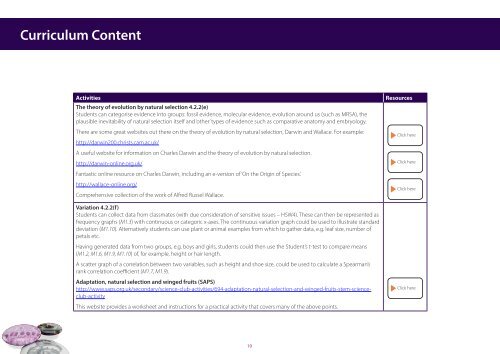BIOLOGY A
234241-classification-and-evolution-delivery-guide
234241-classification-and-evolution-delivery-guide
Create successful ePaper yourself
Turn your PDF publications into a flip-book with our unique Google optimized e-Paper software.
Curriculum Content<br />
Activities<br />
The theory of evolution by natural selection 4.2.2(e)<br />
Students can categorise evidence into groups: fossil evidence, molecular evidence, evolution around us (such as MRSA), the<br />
plausible inevitability of natural selection itself and ‘other’ types of evidence such as comparative anatomy and embryology.<br />
There are some great websites out there on the theory of evolution by natural selection, Darwin and Wallace. For example:<br />
http://darwin200.christs.cam.ac.uk/<br />
A useful website for information on Charles Darwin and the theory of evolution by natural selection.<br />
http://darwin-online.org.uk/<br />
Fantastic online resource on Charles Darwin, including an e-version of ‘On the Origin of Species’.<br />
http://wallace-online.org/<br />
Comprehensive collection of the work of Alfred Russel Wallace.<br />
Variation 4.2.2(f)<br />
Students can collect data from classmates (with due consideration of sensitive issues – HSW4). These can then be represented as<br />
frequency graphs (M1.3) with continuous or categoric x-axes. The continuous variation graph could be used to illustrate standard<br />
deviation (M1.10). Alternatively students can use plant or animal examples from which to gather data, e.g. leaf size, number of<br />
petals etc.<br />
Having generated data from two groups, e.g. boys and girls, students could then use the Student’s t-test to compare means<br />
(M1.2, M1.6, M1.9, M1.10) of, for example, height or hair length.<br />
A scatter graph of a correlation between two variables, such as height and shoe size, could be used to calculate a Spearman’s<br />
rank correlation coefficient (M1.7, M1.9).<br />
Adaptation, natural selection and winged fruits (SAPS)<br />
http://www.saps.org.uk/secondary/science-club-activities/694-adaptation-natural-selection-and-winged-fruits-stem-scienceclub-activity<br />
This website provides a worksheet and instructions for a practical activity that covers many of the above points.<br />
Resources<br />
Click here<br />
Click here<br />
Click here<br />
Click here<br />
10


